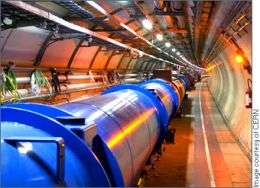October 20, 2009 weblog
LHC now colder than deep space

(PhysOrg.com) -- The LHC (Large Hadron Collider) is once again colder than deep space as it is prepared for experiments to resume in late November.
The LHC's eight sectors have all been cooled to 1.9 kelvin (-271 C, or -456 F) using cryogenic lines containing liquid helium. This operating temperature is colder than conditions in deep space, which is estimated to be 2.7 K. Zero K is the lowest temperature possible.
The magnets that bend particle beams around the LHC need to be this cold because at these low temperatures they become superconductors, channeling electric current with almost no power loss, and with zero resistance.
In the LHC experiments, two beams of protons will be fired in opposite directions through the ring between the magnets. They will reach close to the speed of light, and smash into one another at four collision points. The collisions are predicted to produce thousands of particles, which will be studied by the scientists, The results are expected to shed new light on the nature of the universe and its beginnings.
A magnet problem dubbed a "quench" in September 2008 resulted in the LHC particle accelerator being shut down after a tonne of liquid helium leaked into the LHC tunnel. The facility had to be warmed up to allow for the approximately $40 million in repairs to be carried out.
Now the LHC ring is cooled again magnet powering tests can be carried out. In the commissioning process the magnets are powered with gradually increasing current until the operating current of 6 kA is reached. This current is needed to guide the particle beams, which will travel at a nominal energy of 3.5 TeV.
CERN will also carry out thorough tests of components of the new quench protection system before the particle collision experiments can begin. The system comprises hundreds of new detectors designed to detect any splice malfunctions at a sufficiently early stage for the machine to be protected. The new system should prevent further incidents like the one that shut down the LHC last year.
A low intensity beam test involving parts of the collider could be carried out before November, while particle collision experiments with low intensity beams are expected in late November. If these are successful, the energy of the beams will be increased, with high energy collisions scheduled for December or January.
Director of communications with CERN, James Gillies said the high-energy collisions would require delicate operation of the accelerator. He likened the relative distances in the operation to firing knitting needles across the Atlantic and making them smash into each other half way across.
The LHC is the most powerful particle accelerator ever built. Its magnets are lined end to end in a circular tunnel 27 km in circumference, buried 50 to 175 meters underground beneath the border between Switzerland and France. Operated by CERN (European Organization for Nuclear Research) at Geneva, the facility is designed to recreate conditions immediately following the Big Bang.
More information:
• CERN bulletin: cdsweb.cern.ch/journal/article … lletin&category=News%20Articles&number=3&ln=en
• 3 Questions: Steven Nahn on the elusive Higgs boson
© 2009 PhysOrg.com
















